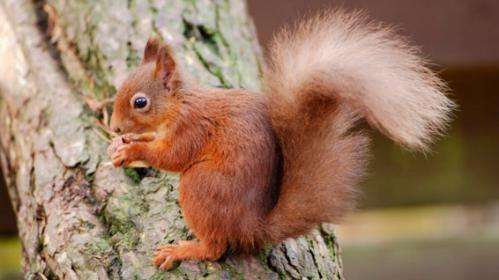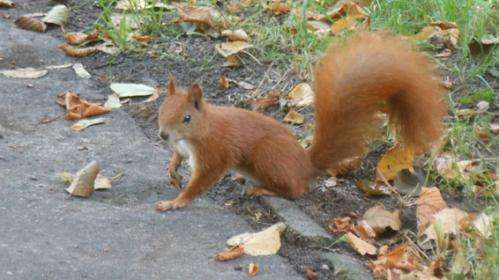New research involving a Heriot-Watt scientist predicts how the squirrelpox virus could spread in grey squirrel populations in Scotland, and will be useful in planning how best to protect red squirrels.
The report, undertaken for Scottish Natural Heritage (SNH) describes the results of disease modelling work carried out on squirrelpox virus. The disease has been a major factor in the decline of red squirrels in England and Wales.
The squirrelpox virus is believed to have been introduced to the UK by non-native grey squirrels, which can carry the disease without showing symptoms. In contrast, red squirrels exposed to the virus experience severe symptoms and high mortality rates.
The first reports of squirrelpox in Scotland were in 2005 along the border with Cumbria. Since then, Saving Scotland's Red Squirrel (SSRS) staff, volunteers, forest rangers, landowners and gamekeepers have made significant efforts to contain the spread of the virus and red squirrels have continued to thrive in many areas, for example, in Thornhill and Castlemilk in Dumfrieshire. In other areas in Southern Scotland, however, the virus has continued to spread.
SNH commissioned research to assess the likely future spread of the virus and to determine where to focus conservation efforts. Professor Andy White from Heriot-Watt University and ecological consultant, Dr Peter Lurz, carried out the study.
Professor White and Dr Lurz used mathematical techniques to represent the changing densities of red and grey squirrel populations and the transmission of squirrelpox virus. The work explored how the disease could spread through Scotland, based on estimated squirrel densities from digital land-cover maps. Grey squirrel control was also simulated to examine what effect it could have in controlling the disease. Currently, grey squirrel populations extend as far north as Argyll and Tayside, with an isolated grey squirrel population in Aberdeenshire.
Andy White, Professor of Mathematics at Heriot-Watt, said, "Our work showed that it will be challenging to contain the squirrelpox virus in southern Scotland, where there is abundant woodland suited to grey squirrels. Without grey squirrel control, the virus will likely continue to spread across all areas where grey squirrels exist.
"Importantly, however, our research found that the virus is unlikely to spread through areas that only have red squirrel populations, which is great news for the red squirrels of the Highlands, parts of Tayside, Argyll, Moray and Aberdeenshire. The key will be to remain vigilant for grey squirrels trying to colonise these areas."
The report also included a preliminary study on how best to defend populations of native squirrels in 'Red Squirrel Stronghold' sites, when squirrelpox is present in the surrounding area.
There are 18 stronghold sites across Scotland, plus the Isle of Arran. These sites, identified by Forestry Commission Scotland, total approximately 100,000 hectares and are a mixture of public and private forests. All are large forests are being managed with red squirrels as a high priority with a view to securing their populations in the long-term. They have in common a large proportion of woodland types that aren't well suited to grey squirrels, for example, forests with a lot of Sitka spruce and little beach or oak.
The Fleet Basin in Dumfries and Galloway, an area dominated by Sitka spruce habitats, was used as an example in the mathematical modelling study. Professor White said "Although red squirrel populations may experience occasional squirrelpox disease outbreaks that lead to localised population crashes, squirrelpox will 'burn-out' rapidly and some reds will avoid infection. The red squirrel populations will then return to pre-infection densities provided grey squirrels are kept at very low levels in these forests through on-going control."
Squirrelpox is already endemic in much of Northern England, where conservation efforts are focused on maintaining red squirrel strongholds.
Ron Macdonald, SNH Director Policy & Advice said, "Red squirrels were voted Scotland's second favourite animal in last year's Big 5 vote with many people regularly seeing them. However, they are under pressure from competition with grey squirrels and from squirrelpox which is spreading northwards. This report provides us with valuable information on how best to protect important populations of red squirrels in the face of the increasing spread of squirrelpox."
Modelling is underway at Heriot-Watt University, under Dr White's supervision, to help further understand the factors that affect the impact of the disease. Meanwhile the SSRS team are continuing with an enhanced squirrelpox surveillance programme and is alerting the public to be vigilant for the signs of squirrelpox.
Provided by Heriot-Watt University























